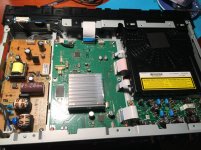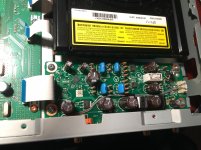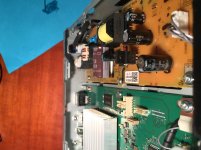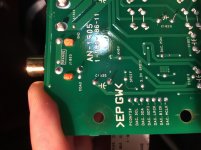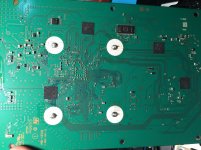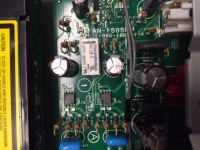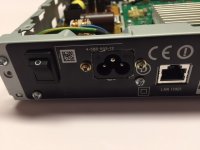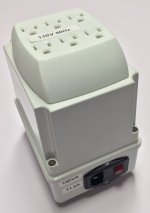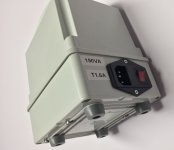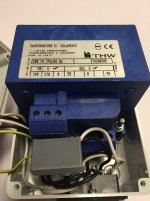I got this Sony some time ago mainly for playing sacd files. It was advertised as an audiophile universal player.
It has performed flawlessly, especially as a transport, it plays stereo or multichannel, flac, ape, dsf over DLNA.
Unfortunately analog out is poor, it's no better than my old bdp s470.
The sound is compressed, highs are unpleasant, and bass doesn't dig deep.
I opened it up and searched for the DAC chip, but I can't find it, probably is under the big heatsink and I'm not going to remove it at the moment.
It seems to have a pair of JRC 4580 as opamps, which should be decent enough, and I prefer not to touch them since they're very close to some surface mount components.
I was thinking to bypass the analog stage, but I have no clue what dac is inside.
The cable connecting the main pcb with the analog pcb has the markings: 'PCONT2', 'DAC.SCL', 'DAC.SDA', DAC.SDTI', DAC.LRCK', 'DAC.BICK', 'DAC.MCLK',
Any thoughts?
It has performed flawlessly, especially as a transport, it plays stereo or multichannel, flac, ape, dsf over DLNA.
Unfortunately analog out is poor, it's no better than my old bdp s470.
The sound is compressed, highs are unpleasant, and bass doesn't dig deep.
I opened it up and searched for the DAC chip, but I can't find it, probably is under the big heatsink and I'm not going to remove it at the moment.
It seems to have a pair of JRC 4580 as opamps, which should be decent enough, and I prefer not to touch them since they're very close to some surface mount components.
I was thinking to bypass the analog stage, but I have no clue what dac is inside.
The cable connecting the main pcb with the analog pcb has the markings: 'PCONT2', 'DAC.SCL', 'DAC.SDA', DAC.SDTI', DAC.LRCK', 'DAC.BICK', 'DAC.MCLK',
Any thoughts?
Attachments
Not familiar with that unit but looking on the net it's a top billed BR player. On my Pioneer DV-79AVi I had lousy playback until I turned off all the video related stuff and used it exclusively for 2 channel playback. At that point it really sounded great.
Maybe a similar issue with this unit?
BillWojo
Maybe a similar issue with this unit?
BillWojo
There's an "audio direct" button, when pressed it shuts off video section, but really I don't hear much difference.Not familiar with that unit but looking on the net it's a top billed BR player. On my Pioneer DV-79AVi I had lousy playback until I turned off all the video related stuff and used it exclusively for 2 channel playback. At that point it really sounded great.
Maybe a similar issue with this unit?
BillWojo
As a blu ray player is great and picture quality is very good, just stereo sound is not even close to any of my cheap cd players..
Even though an external DAC would be the best choice, there's no dsd over spidf output..
I also also use the analog outputs of the UHP-H1 to play SACD and CDs. I haven't noticed the faults you mentioned. This player is actually a noticeable upgrade from my previous setup. I don't hear any difference between the CD played trough the UHP-H1 analog outputs and the corrisponding Flac file played with the computer trough my portable DAC. I use a DIY single ended tube amplifier, with global feedback to reduce distortion and lower the output impedence (10W per channel). The speaker system is a self-built passive sub with a 8 inch driver, coupled with Q-acoustics 3020 or vintage Pioneer satellites. My setup is not high-end so maybe I simply cannot notice the issue due to speaker/amp deficiencies, but really I don't hear any obvious fault in the source.
I opened up the player a few months ago just to see if there is any easy path for a upgrade but it seems to be a well built consumer grade device. It would be costly to rebuild the analog section in a significantly better way, and I will rather spend this money for a new audio-oriented player. Ad far as I remember, the analog board layout is conventional and is pretty easy to trace the signals back to the DAC. It is the IC next to the flat cable, I believe.
The signal path is left to right; the power supply section is at the side near the back of the device, the two audio channels runs at the center and at the other side of the board. A nice and professional layout. They even used trough-hole resistors on most audio path, instead of the cheaper SMD version. You may change the coupling capacitors pretty easily, if you feel that this will improve the sound. There is free space all around them.
I opened up the player a few months ago just to see if there is any easy path for a upgrade but it seems to be a well built consumer grade device. It would be costly to rebuild the analog section in a significantly better way, and I will rather spend this money for a new audio-oriented player. Ad far as I remember, the analog board layout is conventional and is pretty easy to trace the signals back to the DAC. It is the IC next to the flat cable, I believe.
The signal path is left to right; the power supply section is at the side near the back of the device, the two audio channels runs at the center and at the other side of the board. A nice and professional layout. They even used trough-hole resistors on most audio path, instead of the cheaper SMD version. You may change the coupling capacitors pretty easily, if you feel that this will improve the sound. There is free space all around them.
Thanks,I also also use the analog outputs of the UHP-H1 to play SACD and CDs. I haven't noticed the faults you mentioned. This player is actually a noticeable upgrade from my previous setup. I don't hear any difference between the CD played trough the UHP-H1 analog outputs and the corrisponding Flac file played with the computer trough my portable DAC. I use a DIY single ended tube amplifier, with global feedback to reduce distortion and lower the output impedence (10W per channel). The speaker system is a self-built passive sub with a 8 inch driver, coupled with Q-acoustics 3020 or vintage Pioneer satellites. My setup is not high-end so maybe I simply cannot notice the issue due to speaker/amp deficiencies, but really I don't hear any obvious fault in the source.
I opened up the player a few months ago just to see if there is any easy path for a upgrade but it seems to be a well built consumer grade device. It would be costly to rebuild the analog section in a significantly better way, and I will rather spend this money for a new audio-oriented player. Ad far as I remember, the analog board layout is conventional and is pretty easy to trace the signals back to the DAC. It is the IC next to the flat cable, I believe.
The signal path is left to right; the power supply section is at the side near the back of the device, the two audio channels runs at the center and at the other side of the board. A nice and professional layout. They even used trough-hole resistors on most audio path, instead of the cheaper SMD version. You may change the coupling capacitors pretty easily, if you feel that this will improve the sound. There is free space all around them.
Can you point the coupling capacitors, I'm no expert and there are no small caps near the rca,
The coupling capacitors are the two 330uF 25V electrolytic capacitors at both sides of the muting relay. They connect the output of the op amp to the RCA connectors. On my board they are marked Nippon Chemicon.
There is also a filter to block the RF, implemented with a small value SMD ceramic capacitor and a few resistors between the coupling cap and the output connector. You may want to also remove that, but I believe that Sony put the filter there for a reason so I personally would leave it as is. The 4 light blue film capacitors near the op amp are placed between the DAC differential outputs and the op amp inputs, so they also may contribute to the sound.
The first time I opened up the Sony UHP-H1, I struggled for a while. The sequence is this: remove the two black screws at the left and right sides of the rear panel and slide both plastic panels towards the back to remove them. Then remove the 4 screws that holds in place the top plastic cover and slide the cover towards the front with some force. The plastic cover will come out, revealing the metal cover underneath. At this point, just remove the required screws.
The only modification I made until now is the addition of a mechanical on/off switch, because I noticed that this player is really never off, it still draws current even when is supposedly "off". While I was at it, I put a IEC connector to use a replaceable power cord with ground connection. This solved a interference between the servo of this player and a tube preamp I have. I use grid leak polarization with a 10 Mohm resistor, extremely sensitive to any stray RF.
There is also a filter to block the RF, implemented with a small value SMD ceramic capacitor and a few resistors between the coupling cap and the output connector. You may want to also remove that, but I believe that Sony put the filter there for a reason so I personally would leave it as is. The 4 light blue film capacitors near the op amp are placed between the DAC differential outputs and the op amp inputs, so they also may contribute to the sound.
The first time I opened up the Sony UHP-H1, I struggled for a while. The sequence is this: remove the two black screws at the left and right sides of the rear panel and slide both plastic panels towards the back to remove them. Then remove the 4 screws that holds in place the top plastic cover and slide the cover towards the front with some force. The plastic cover will come out, revealing the metal cover underneath. At this point, just remove the required screws.
The only modification I made until now is the addition of a mechanical on/off switch, because I noticed that this player is really never off, it still draws current even when is supposedly "off". While I was at it, I put a IEC connector to use a replaceable power cord with ground connection. This solved a interference between the servo of this player and a tube preamp I have. I use grid leak polarization with a 10 Mohm resistor, extremely sensitive to any stray RF.
Attachments
Thank you mate for the detailed post..The coupling capacitors are the two 330uF 25V electrolytic capacitors at both sides of the muting relay. They connect the output of the op amp to the RCA connectors. On my board they are marked Nippon Chemicon.
There is also a filter to block the RF, implemented with a small value SMD ceramic capacitor and a few resistors between the coupling cap and the output connector. You may want to also remove that, but I believe that Sony put the filter there for a reason so I personally would leave it as is. The 4 light blue film capacitors near the op amp are placed between the DAC differential outputs and the op amp inputs, so they also may contribute to the sound.
The first time I opened up the Sony UHP-H1, I struggled for a while. The sequence is this: remove the two black screws at the left and right sides of the rear panel and slide both plastic panels towards the back to remove them. Then remove the 4 screws that holds in place the top plastic cover and slide the cover towards the front with some force. The plastic cover will come out, revealing the metal cover underneath. At this point, just remove the required screws.
The only modification I made until now is the addition of a mechanical on/off switch, because I noticed that this player is really never off, it still draws current even when is supposedly "off". While I was at it, I put a IEC connector to use a replaceable power cord with ground connection. This solved a interference between the servo of this player and a tube preamp I have. I use grid leak polarization with a 10 Mohm resistor, extremely sensitive to any stray RF.
I also struggled a bit to open it up, if anyone has to replace the drive, it can be removed with the tray open, because the plastic front cover slide down when tray is open..
330/25v are odd value for decoupling, probably there's a bit of DC offset, if bypassed, maybe I'm going to postpone any mod..
It is a odd value indeed, maybe on your player the capacitors have degraded. The DAC on this board is the AK4452 and the op amp low pass filter is similar to the sample circuit depicted on the 4452 datasheet. The two 470pf capacitors on the datasheet are the SMD parts you see on the right side of each operational amplifier. I haven't checked their value with the meter, so maybe Sony changed the value a little. Not really a high end solution, but some SMD parts have very good electrical propriety and probably Sony fitted a suitable type. If you want to rebuild the circuit completely to higher specifications, the raw DAC output signals are easily accessible at the traces that are connected to the trough-hole film capacitors. My original idea was to have an external chassis with a new output stage built with vacuum tubes, but ultimately the stock circuit works well enough for me at the moment.
My Pioneer has a button to shut down the video section also. The menu that you want to look at will let you take it out of 7.1 or 5.1 mode and let you select the main outs for 2 channel mode. Right now it may be processing the signal to split it up for multi speaker mode. Doing that turned my Pioneer from yuk to very impressive. Take a look.
BillWojo
BillWojo
A little update,
I bypassed the wrong capacitor and a resistor burnt immediately after pluggin in.
Fortunately after replacing everything is good again, thanks also to pcan..
I bypassed some of the output by connecting rca directly to + leg of coupling capacitors, after lifting them.
I can't say that the sound is definitely better, but highs and midrange seem more airy, unfortunately bass is not that punchy. Also the gain is practically the same, I thought the sound would be weaker.
I'm using some Mundorf 10uf which are too big to install in the case if I decide to keep the bypass..
What is the smallest value of film cap you'd recommend, something smaller than 10uf cap?
The space is very tight.
I bypassed the wrong capacitor and a resistor burnt immediately after pluggin in.
Fortunately after replacing everything is good again, thanks also to pcan..
I bypassed some of the output by connecting rca directly to + leg of coupling capacitors, after lifting them.
I can't say that the sound is definitely better, but highs and midrange seem more airy, unfortunately bass is not that punchy. Also the gain is practically the same, I thought the sound would be weaker.
I'm using some Mundorf 10uf which are too big to install in the case if I decide to keep the bypass..
What is the smallest value of film cap you'd recommend, something smaller than 10uf cap?
The space is very tight.
You may use a coupling capacitor calculator, for example this one: Coupling Capacitor Calculator by V-Cap
If your amplifier input impedence is 10 Kohm and the desired -3db cutoff frequency is 5 Hz, the result is about 3 uF.
If you play standard CDs, be sure to check the DSEE HX status in the setup. If you set this parameter ON or Auto, 44KHz and compressed audio sources will be routed trough a signal processor/expander.
If your amplifier input impedence is 10 Kohm and the desired -3db cutoff frequency is 5 Hz, the result is about 3 uF.
If you play standard CDs, be sure to check the DSEE HX status in the setup. If you set this parameter ON or Auto, 44KHz and compressed audio sources will be routed trough a signal processor/expander.
Unfortunately it also upsample dts stream from movies to 96khz, so it cant be decoded by the receiver.If you play standard CDs, be sure to check the DSEE HX status in the setup. If you set this parameter ON or Auto, 44KHz and compressed audio sources will be routed trough a signal processor/expander.
Recently, when in search for a replacement for both the CD and the DVD players, I also had a glance on this unit which appears to be a bargain. But eventually I opted for the Panasonic DMP-UB900 that offers some more features and an even better analog audio section - for more than twice the price, though. And it is no Sony  .
.
But it is worth it's money.
Best regards!
But it is worth it's money.
Best regards!
The power consumption is 14W, a cheap standard 25VA toroidal transformer with dual 115V primary windings and dual 115V secondary windings will do the job. Wire primary in series and secondary in parallel. Or you may modify the power supply board. Trace the circuit before the switching MOS: if there is a voltage dubler, replace it with a full bridge rectifier, and rewire/change filter capacitors accordingly. If the switching IC has recognizable markings, check the datasheet. I believe that US players are locked to DVD region 1.
Ok now. I have ordered a cheap China external transformer to make it work.
For those who feel that this gear is not an audiophile grade component, please read these 2 reviews:
What hifi
Stereophile
Both gave good comments on it. Stereophile added that the analogue out was a standard one but the coaxial output was much better.
I don't understand the 2nd point. Do we have to connect it to a 3rd-party DAC in order to enjoy Sony UHP-H1's highest sound quality?
For those who feel that this gear is not an audiophile grade component, please read these 2 reviews:
What hifi
Stereophile
Both gave good comments on it. Stereophile added that the analogue out was a standard one but the coaxial output was much better.
I don't understand the 2nd point. Do we have to connect it to a 3rd-party DAC in order to enjoy Sony UHP-H1's highest sound quality?
Be careful with the cheap China sourced step down "travel" transformer. Some of them have extremely poor load regulation, they output 140-150v when loaded lightly (such as this case), then they drop to 110-120V at high load with severely distorted output waveform. And they get hot. And because they don't have any overload protection while using outdated insulating matherials, they will burn with smoke and fire if the output is shorted. Just check yours before putting it in service: connect a incandescent light bulb at the output and take some measurements, see what's inside the box.
For my vintage 110V audio gears I use a surplus 55+55v industrial control transformer, they are cheap, massively oversized and are built to last decades. I've put it inside a standard plastic electrical box; the UL listed General Electric USA wall plug (actually, a multi tap wall adapter) has been the most difficult item to source locally because UL listed electrical items for the north american market are unobtanium in Europe. Amazon Global has been the cheapest route. 55+55v transformers are still pretty common here. They usually are toroidal transformers now, of course, and cheaper and more readily available than 1:1 insulation transformers or 110+110 transformers.
For my vintage 110V audio gears I use a surplus 55+55v industrial control transformer, they are cheap, massively oversized and are built to last decades. I've put it inside a standard plastic electrical box; the UL listed General Electric USA wall plug (actually, a multi tap wall adapter) has been the most difficult item to source locally because UL listed electrical items for the north american market are unobtanium in Europe. Amazon Global has been the cheapest route. 55+55v transformers are still pretty common here. They usually are toroidal transformers now, of course, and cheaper and more readily available than 1:1 insulation transformers or 110+110 transformers.
Attachments
- Status
- This old topic is closed. If you want to reopen this topic, contact a moderator using the "Report Post" button.
- Home
- Source & Line
- Digital Source
- Sony UHP-H1
